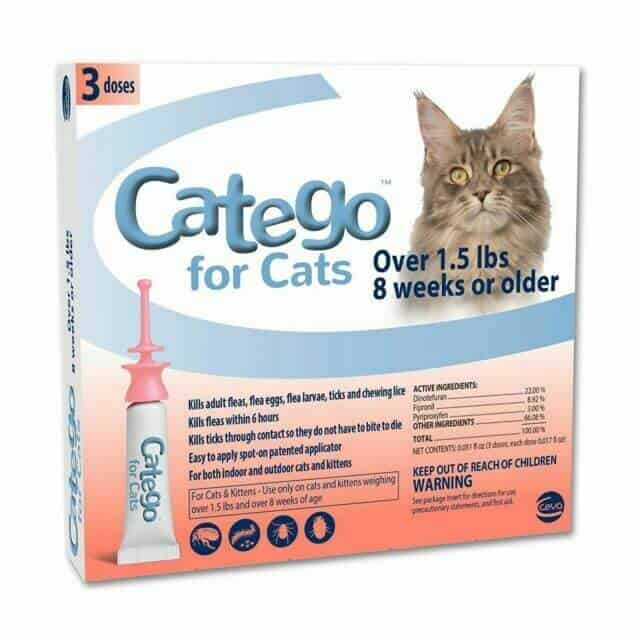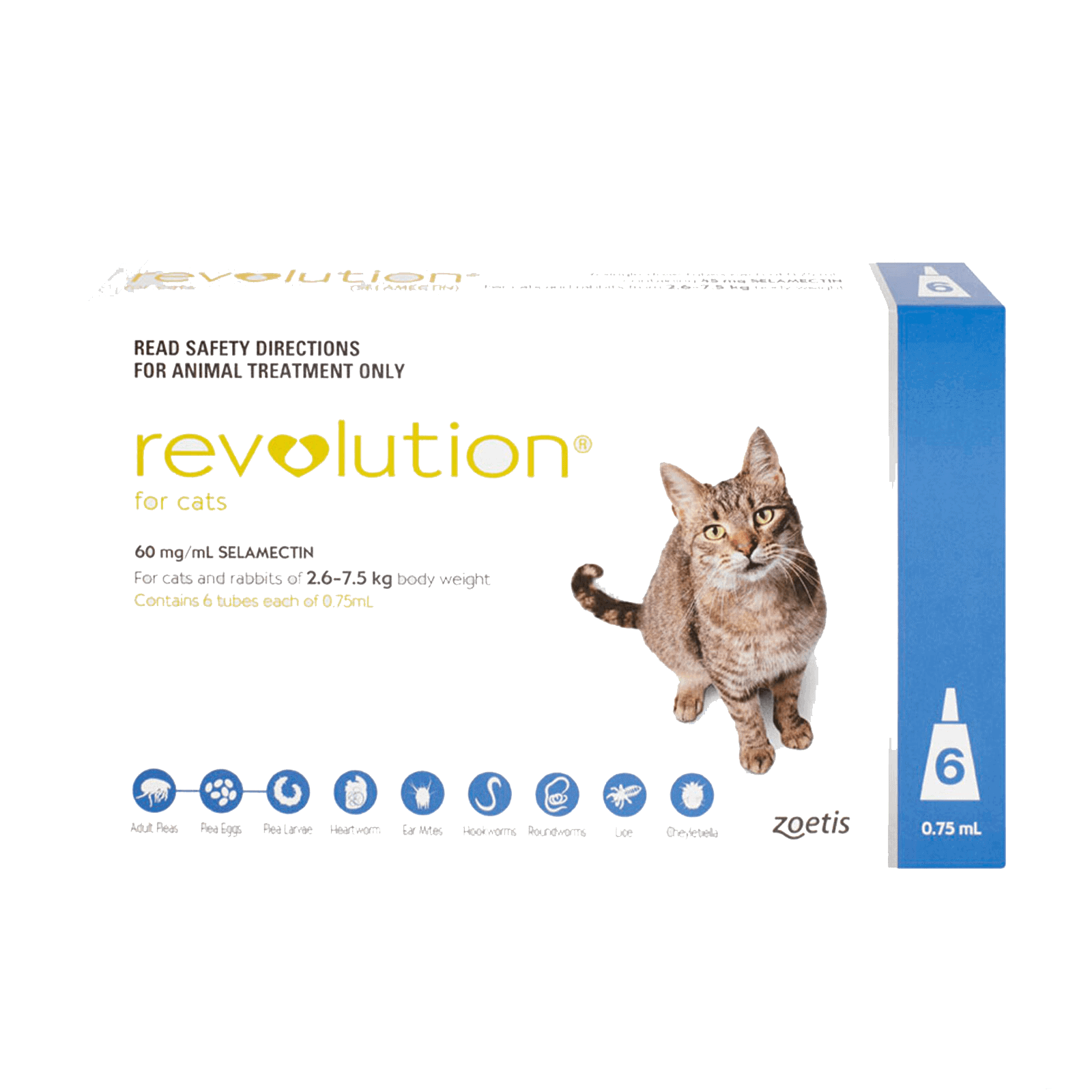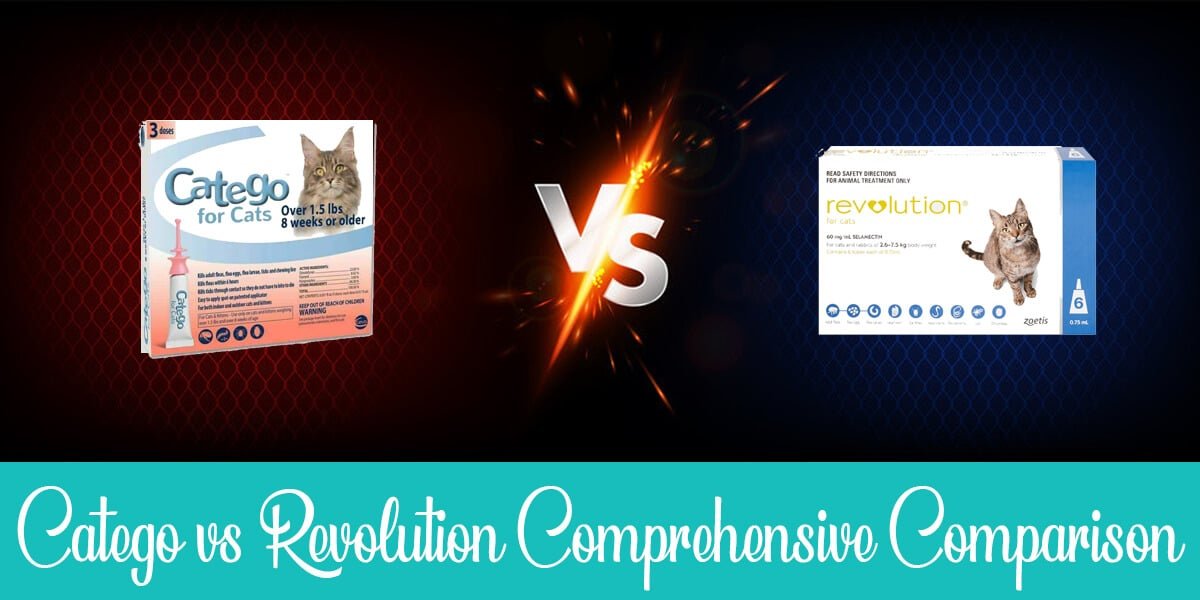Fleas represent a massive problem for cat owners, as a single flea can lay up to 50 eggs per day. This is why finding a potent flea treatment is on the do list of every cat lover. In this article, we will talk about a detailed comparison of Catego vs Revolution to help you decide on the most appropriate treatment.
This detailed guide will also tell you about:
- The benefits of each treatment.
- The limitation of each treatment.
- How to use each one.
- Lots more.
So, if you’re looking for a fast-acting treatment to keep fleas at bay, you’ve come to the right place. Let’s dive right in.
| Image | Product | Details | Price |
|---|---|---|---|
 | Catego | Best for fast results | Check Price |
 | Revolution | Wider spectrum of protection from parasites | Check Price |
Table of Contents
Catego vs Revolution Overview
Catego contains three active chemicals; pyriproxyfen, dinotefuran, and fipronil. Not only does it get rid of adult fleas, but it also eliminates the eggs and larvae, thus breaking the whole life cycle. Revolution has 2 active ingredients; Selamectin and Sarolaner. It travels through the bloodstream to kill fleas within 6 hours. It also gets rid of heartworms, hookworms, roundworms, and ear mites.
Catego vs Revolution Comparison
Both Catego and Revolution can be used to eliminate a flea infestation in your feline. However, each one of them has distinctive features and works according to a different mechanism. In this section, we analyze the features of each treatment and compare them to help you pick the right one for your cat.
Target Microorganisms
Catego is an efficient treatment that targets fleas and chewing lice. Revolution has a broader spectrum as it kills fleas and prevents heartworms. Moreover, it eliminates ear mites, roundworms, and hookworms.
Both treatments can be used to prevent a current infestation from spreading. Once applied, both treatments can deliver long-term protection.
Active Ingredients
Although both Catego and Revolution are efficient treatments, they contain different active ingredients that eliminate fleas according to different mechanisms.
Dinotefuran, Pyriproxyfen, and fipronil in Catego combine together to stop the fleas’ life cycle. The formula kills the adult fleas and slows down the growth of the offspring, and ultimately kills them. It also kills dormant eggs and protects against future infestation.
Selamectin and Sarolaner are the active ingredients in Revolution. Selamectin is a potent treatment that prevents the infestation of heartworms when your pet is exposed to the Dirofilaria immitis larvae.
When Revolution is applied to the cat’s skin, both the Selamectin and Sarolaner get absorbed by the skin and travel through the bloodstream. They get rid of fleas before they start laying eggs.
How Do They Work?
Catego and Revolution are both topical treatments applied to your cat’s skin to get rid of fleas. Catego can be applied to the skin and starts showing results within 6 hours of application. Within the first 3 hours of application, Catego achieves about 97% efficiency.
Ideally, you should apply it once per month for protection, but you can apply it more often in case of a serious infestation. Catego arrives in packs of 1, 3, or 6 doses.
Revolution is a topical treatment that gets absorbed by the cat’s skin. The active ingredients kill adult fleas and other parasites like heartworms.
Within the first 36 hours, you can start seeing the results of Revolution, but it starts killing fleas within 6 hours. It comes in packs of 6 doses and should be applied monthly to prevent flea infestations.
Both Catego and Revolution come in easy-to-use tubes. You need to locate the infected spot, which is usually located on the neck, and part the cat’s fur to apply the treatment directly to the skin to allow for the best absorption.
Related: in-depth Revolution vs Advantage Multi comparison
Dosage
Catego can be used safely by kittens after the age of 8 weeks. Medicated, pregnant, and lactating cats shouldn’t use Catego.
Catego’s dosage should be applied monthly, even in the case of a severe infestation. Since it’s fast-acting, you can start seeing results within hours.
One application should be applied for a full-size cat that weighs above 1.5 pounds. You should wait and monitor your feline. If you see that the infestation hasn’t improved or disappeared, you can apply another dose after one month.
Revolution can be used on kittens that are 6 weeks or older. However, the safe use of Revolution by pregnant or lactating cats hasn’t been evaluated.
Revolution’s dose is determined by the vet based on the cat’s weight. One dose is enough for a cat that weighs 2.8 pounds, and you can add more dosages for bigger cats. Since it travels through the bloodstream, you shouldn’t exceed the dosage to prevent the occurrence of side effects.
Side Effects
Although Catego is safe to use by most cats, some felines show allergic reactions due to sensitivity to one of the ingredients. If your cat is sensitive to any of the active ingredients, it might experience some uncomfortable symptoms like redness, itchiness, scratching, vomiting, and general discomfort.
After applying Catego to your cat’s skin, you should monitor it closely to make sure that there is no adverse reaction. If your cat starts showing sensitivity symptoms, you should bath it using a generous amount of water and a gentle cat shampoo to remove the treatment from the cat’s skin and fur. If the cat keeps on showing signs of discomfort, you should take it to the vet.
Revolution has some rare side effects but is generally safe for use. Almost less than 1% of the cats experienced digestive issues and discomfort after the application of Revolution. In other rare cases, there was a temporary hair loss where the treatment was applied. Nevertheless, the hair grew back within months, and there were no permanent side effects.
Other temporary side effects that your cat might experience include the clumping of fur or a change in its texture. In most cases, the cat’s fur can become too stiff and weak. The skin and the fur could show some minor discoloration, which might get worse if the treatment was repeated. A powdery residue is quite common, but it’s easy to rinse later.
FAQs
1. How Many Fleas Count As An Infestation?
Finding a flea or two might not be a severe problem. However, if you can see more than 20 fleas on your cat’s body, then this is an infestation that shouldn’t be taken lightly. In some cases, the number of fleas can increase to reach 200 or 300 within a few days.
2. How Do Cats Catch Fleas?
Fleas are annoying parasites that can infect your feline’s body in multiple ways. If your cat spends time outside the house, a flea can travel on its body and start to lay eggs that hatch, and the fleas multiply in a very short period.
In some cases, you might be the reason why your cat got fleas. The fleas can jump on your clothes and then jump onto your cat’s body. If your cat has been playing with another pet, the fleas can jump from the other animal’s body to yours.
3. How Fast Do Fleas Multiply On The Cat’s Body?
Fleas multiply rapidly, as long as there’s no treatment that breaks their reproductive cycle. An adult flea can lay between 20 and 50 eggs per day as soon as it reaches maturity. This means that within one month of infestation, each flea can produce up to 1500 fleas that continue the cycle.
This is why it’s crucial to apply a potent and fast-acting treatment that either kills the flea at all stages of the life cycle or kills adult fleas and prevents the younger offspring from reaching sexual maturity. In most cases, flea treatments should be applied as monthly preventive treatments to keep fleas at bay.
4. How Can You Tell That Your Cat Has Fleas?
There are several signs that your cat has fleas.
– Fleas cause skin irritation and itching. If you see that your cat is scratching and licking its body all the time, you need to check its body to see if there are fleas. Keep an eye on excessive scratching because it’s a tell-tale sign.
– Your cat might be biting itself. This is a sign of huge discomfort that is usually related to a serious flea infestation.
– Skin problems and hair loss are side effects of a serious flea infestation that was not treated. Your cat might be allergic to the saliva of fleas which cause hair loss.
– Your feline might be too uncomfortable and might show signs of aggressiveness. Keep an eye on any change in behavior.
– Flea dirt or black specks show you that your cat is suffering from a flea infestation. Flea dirt is made of flea waste and the undigested blood that the fleas have absorbed from the cat’s body. However, it’s only visible when the flea problem has been ignored for a while.
– In severe cases, your cat might develop pale gums because of blood loss. Flea anemia is more common in kittens because of their small bodies.
Wrap Up
Both Catego and Revolution are potent flea treatments that can get rid of a serious flea infestation fast. However, each one of them contains a different list of active ingredients and works according to a different mechanism.
Catego shows faster results, while Revolution has a wider spectrum and protects your cat from multiple parasites. It’s recommended to check with your vet, so they can recommend the most appropriate treatment for your cat.

I’ve been living with cats since 2008 and I can confidently say I have more feline friends than humans lol. I currently live with 5 cats in different life stages; two of them are less than one year old, one is 2-ish years old and the oldest two are 9-ish years old. I’ve developed a strong bond with cats over the years and I’m eager to share my experience through this blog. You can learn more about my cats here.



